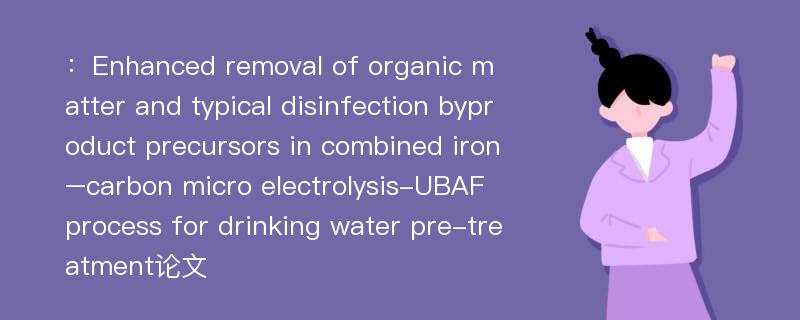
本文主要研究内容
作者(2019)在《Enhanced removal of organic matter and typical disinfection byproduct precursors in combined iron–carbon micro electrolysis-UBAF process for drinking water pre-treatment》一文中研究指出:The organic matter and two types of disinfection byproduct(DBP) precursors in micropolluted source water were removed using an iron–carbon micro-electrolysis(ICME)combined with up-flow biological aerated filter(UBAF) process. Two pilot-scale experiments(ICME-UBAF and UBAF alone) were used to investigate the effect of the ICME system on the removal of organic matter and DBP precursors. The results showed that ICME pretreatment removed 15.6% of dissolved organic matter(DOM)and significantly improved the removal rate in the subsequent UBAF process. The ICME system removed 31% of trichloromethane(TCM) precursors and 20% of dichloroacetonitrile(DCAN) precursors. The results of measurements of the molecular weight distribution and hydrophilic fractions of DOM and DBP precursors showed that ICME pretreatment played a key role in breaking large-molecular-weight organic matter into low-molecular-weight components, and the hydrophobic fraction into hydrophilic compounds, which was favorable for subsequent biodegradation by UBAF.Three-dimensional fluorescence spectroscopy(3D-EEM) further indicated that the ICME system improved the removal of TCM and DCAN precursors. The biomass analysis indicated the presence of a larger and more diverse microbial community in the ICME-UBAF system than for the UBAF alone. The high-throughput sequencing results revealed that domination of the genera Sphingomonas, Brevundimonas and Sphingorhabdus contributed to the better removal of organic matter and two types of DBP precursors. Also, Nitrosomonas and Pseudomonas were beneficial for ammonia removal.
Abstract
The organic matter and two types of disinfection byproduct(DBP) precursors in micropolluted source water were removed using an iron–carbon micro-electrolysis(ICME)combined with up-flow biological aerated filter(UBAF) process. Two pilot-scale experiments(ICME-UBAF and UBAF alone) were used to investigate the effect of the ICME system on the removal of organic matter and DBP precursors. The results showed that ICME pretreatment removed 15.6% of dissolved organic matter(DOM)and significantly improved the removal rate in the subsequent UBAF process. The ICME system removed 31% of trichloromethane(TCM) precursors and 20% of dichloroacetonitrile(DCAN) precursors. The results of measurements of the molecular weight distribution and hydrophilic fractions of DOM and DBP precursors showed that ICME pretreatment played a key role in breaking large-molecular-weight organic matter into low-molecular-weight components, and the hydrophobic fraction into hydrophilic compounds, which was favorable for subsequent biodegradation by UBAF.Three-dimensional fluorescence spectroscopy(3D-EEM) further indicated that the ICME system improved the removal of TCM and DCAN precursors. The biomass analysis indicated the presence of a larger and more diverse microbial community in the ICME-UBAF system than for the UBAF alone. The high-throughput sequencing results revealed that domination of the genera Sphingomonas, Brevundimonas and Sphingorhabdus contributed to the better removal of organic matter and two types of DBP precursors. Also, Nitrosomonas and Pseudomonas were beneficial for ammonia removal.
论文参考文献
论文详细介绍
论文作者分别是来自Journal of Environmental Sciences的,发表于刊物Journal of Environmental Sciences2019年04期论文,是一篇关于,Journal of Environmental Sciences2019年04期论文的文章。本文可供学术参考使用,各位学者可以免费参考阅读下载,文章观点不代表本站观点,资料来自Journal of Environmental Sciences2019年04期论文网站,若本站收录的文献无意侵犯了您的著作版权,请联系我们删除。
